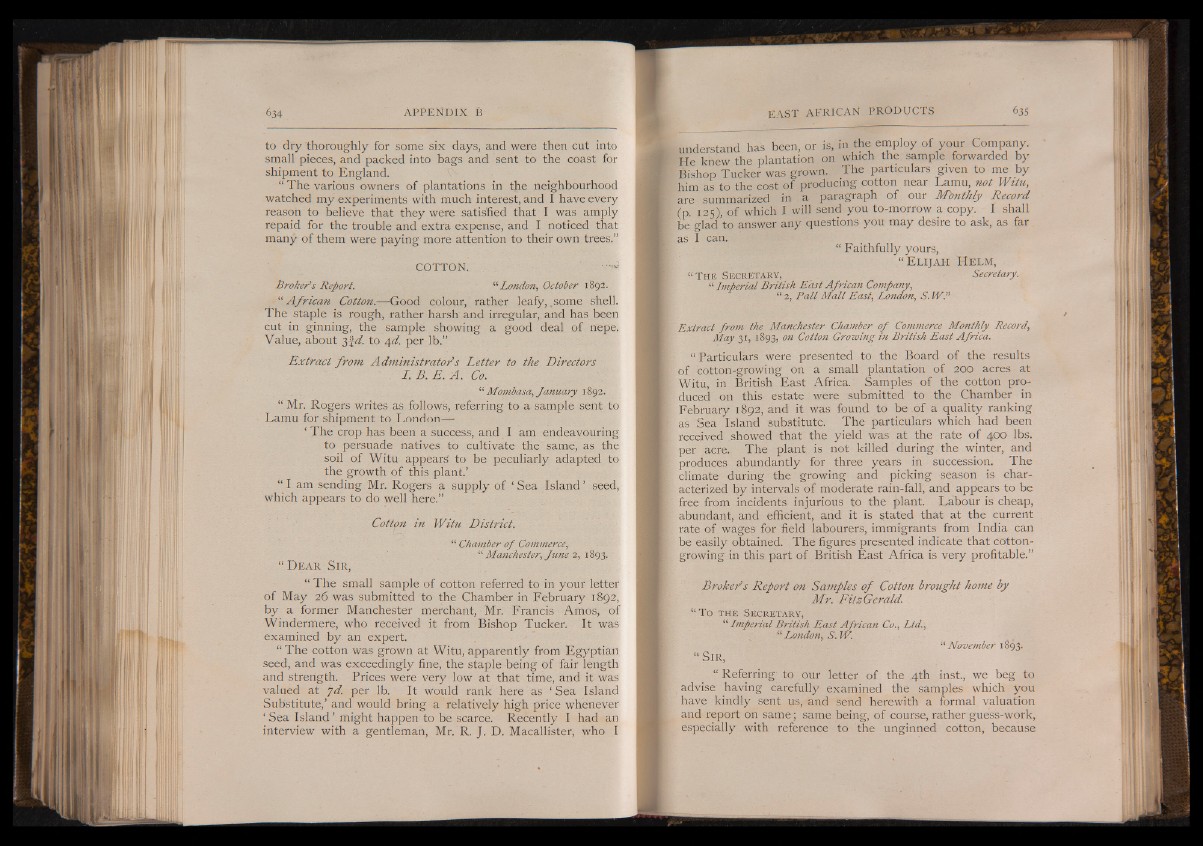
to dry thoroughly for some six days, and were then cut into
small pieces, and packed into bags and sent to the coast for
shipment to England.
“ The various owners of plantations in the neighbourhood
watched my experiments with much interest, and I have every
reason to believe that they were satisfied that I was amply
repaid for the trouble and extra expense, and I noticed that
many of them were paying more attention to their own trees.”
COTTON. £ ;
Broker’s Report. “ London, October 1892.
“ African Cotton.— Good colour, rather leafy,,some shell.
The staple is rough, rather harsh and irregular, and has been
cut in ginning, the sample showing a good deal of nepe.
Value, about 3fd. to \d. per lb.”
Extract from. Administrators Letter to the Directors
I .B .E .A . Co.
“ Mombasa, January 1892.
“ Mr. Rogers writes as follows, referring to a sample sent to
I.amu for shipment to London— ;
‘ The crop has been a success, and I am endeavouring
to persuade natives to cultivate the same, as the
soil of Witu appears to be peculiarly adapted to
the growth of this plant.’
“ I am sending Mr. Rogers a supply of ‘ Sea Island ’ seed,
which appears to do well here.”
Cotton in Witu District.
“ Chamber o f Commerce,
“ Manchester, Tune 2, 1893.
“ D e a r S ir ,
“ The small sample of cotton referred to in your letter
of May 26 was submitted to the Chamber in February 1892,
by a former Manchester merchant, Mr. Francis Amos, of
Windermere, who received it from Bishop Tucker. It was
examined by an expert.
“ The cotton was grown at Witu, apparently from Egyptian
seed, and was exceedingly fine, the staple being of fair length
and strength. Prices were very low at that time, and it was
valued at 7d. per lb. It would rank here as ‘ Sea Island
Substitute,’ and would bring a relatively high price whenever
‘ Sea Island’ might happen to be scarce. Recently I had an
interview with a gentleman, Mr. R. J. D. Macallister, who I
I. understand has been, or is, in the employ of your Company.
I He knew the plantation on which the sample forwarded by
I Bishop Tucker was grown. The particulars given to me by
! him as to the cost of producing cotton near Lamu, not Witu,
I are summarized in a paragraph of our Mbnthly Record
I (p. 125), of which I will send you to-morrow a copy. I shall
I he glad to answer any questions you may desire to ask, as far
l as I can.
“ Faithfully yours,
“ E l i j a h H e l m ,
“ T h e S e c r e t a r y , _ - Secretary.
“ Imperial British East A frican Company,
“ 2, P a ll M a ll East, London, S. IV.”
I Extract from the Manchester Chamber o f Commerce Monthly Record,
May 31, 1893, on Cotton Growing in British East Africa.
“ Particulars were presented to the Board of the results
( of cotton-growing on a small plantation of 200 acres at I Witu, in British East Africa. Samples of the cotton pro-
| duced on this estate were submitted to the Chamber in
I: February 1892, and it was found to be of a quality ranking
I as Sea Island substitute. The particulars which had been
I received showed that the yield was at the rate of 400 lbs.
I per acre. The plant is not killed during the winter, and
| produces abundantly for three years in succession. The
I climate during the growing and picking season is char-
I acterized by intervals of moderate rain-fall, and appears to be
I free from incidents injurious to the plant. Labour is cheap,
I abundant, and efficient, and it is stated that at the current
I rate of wages for field labourers, immigrants from India can
be easily obtained. The figures presented indicate that cotton-
growing in this part of British East Africa is very profitable.”
Broke/s Report on Samples o f Cotton brought home by
Mr. FitzGerald.
“ To t h e S e c r e t a r y ,
“ Imperial British East African Co., Ltd.,
“ London, A. IV.
“ November 1893.
“ S ir,
“ Referring to our letter of the ,4th inst., we beg to
1 advise having carefully examined the samples which you
have kindly sent us, and send herewith a formal valuation
and report on same; same.being, of course, rather guess-work,
especially with reference to the unginned cotton, because